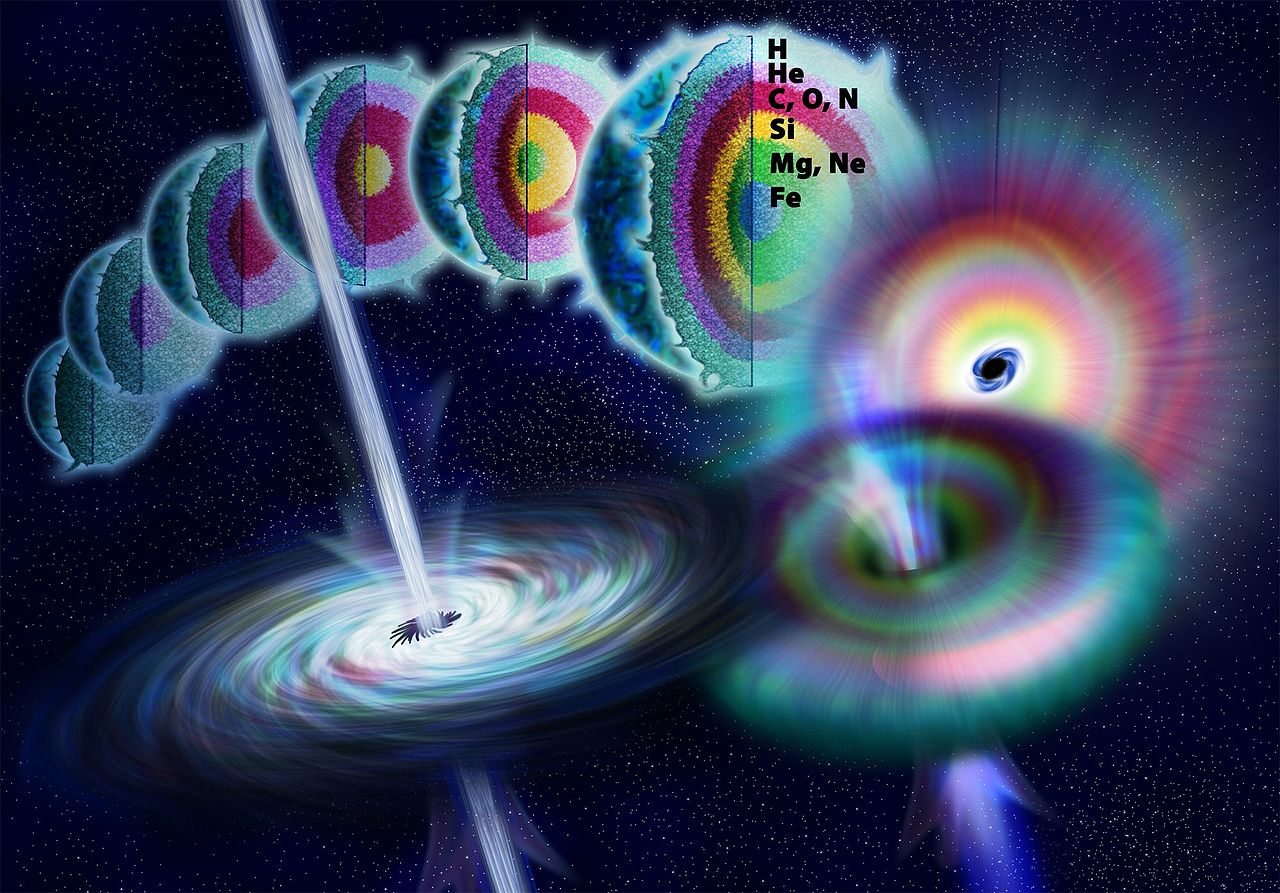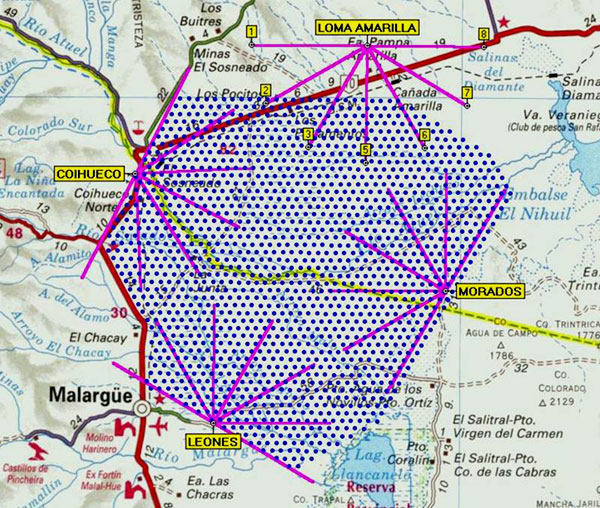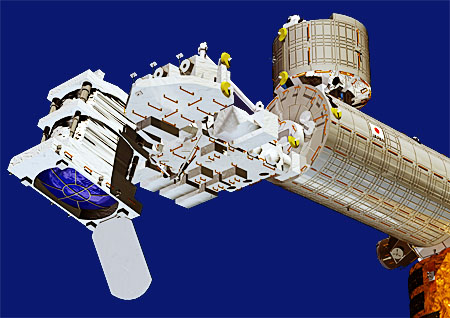| Home | Overview | Science | Instrument | Follow | Collaboration | Publications | Highlights | Photos | JEM-EUSO | UChicago |
EUSO-SPB
|
Science
Uncovering the Mystery Artist's illustration showing the life of a massive star as nuclear fusion converts lighter elements into heavier ones. When fusion no longer generates enough pressure to counteract gravity, the star rapidly collapses to form a black hole. Theoretically, energy may be released during the collapse along the axis of rotation to form a gamma-ray burst. A mysterious cosmic source sends matter particles to Earth from the far reaches of the Universe. These particles can be 10,000,000 times more energetic than the most energetic artificially produced particles, which are accelerated at the Large Hadron Collider, at CERN, in Geneva, Switzerland. We call them ultra-high energy cosmic rays (UHECRs) and they range in energy from above 1018 eV to 1020 eV.Image credit: National Science Foundation For such small subatomic particles to be accelerated to such extreme energies, the sources have to be highly magnetized and energetic. The main suspects in this cosmic mystery are either Supermassive Black Holes in the centers of galaxies (named Active Galactic Nuclei) or explosive events in stars, which create an extremely fast spinning compact star, the birth of a young pulsar, or emit a large flux of gamma-rays in a short period (named gamma-ray bursts). The best way to solve this mystery is to observe these particles at the highest energies in large amounts. At the highest energies ultra-high energy cosmic rays point back to their sources as magnetic fields do not affect these charged particles as much as their lower energy counterparts. There is a great challenge in detecting their miniscule flux on Earth: one of these particles hit a square kilometer (or square mile) area on the ground every century or so! The good news is that the atmosphere transforms one miniscule particle with these extreme energies into hundreds of billions of particles with lower energy. This is Einstein's E=mc2 at work. One highly energetic particle can create many other particle-anti particle pairs through quantum mechanical processes and the energy-mass equivalence. The generated secondary particles excite the nitrogen in our atmosphere, which fluoresces isotropically. The fluorescence signal can be observed at very large distances, tens to hundreds of kilometers away from the track of the particle generated shower. Giant ground observatories were built to unveil this mystery. In Argentina, the Pierre Auger Observatory leads this effort covering 3,000 km2 with detectors. The Telescope Array in Utah now reaches 700 km2 and will reach 3,000 km2 in the next few years. These two giant efforts have not yet solve the mystery but have found some hints that the sources are extragalactic and the sky distribution above 50 EeV (= 5 x 1019 eV) shows the signs of anisotropies. Anisotropies on the sky distribution of UHECRs become apparent at the highest energies as the volume of the universe probed by these observations becomes limited due to the interaction of ultra-high energy cosmic rays and the cosmic microwave background radiation. This interaction is called the GZK effect after the co-discoverers: Greisen, Zatsepin, and Kuzmin. The next generation of UHECR observatories to address the origin of the highest energy particles is designed to observe orders of magnitude more volume of the atmosphere than can be observed with a 3,000 km2 ground array. The best location to monitor large volumes of atmosphere is from space. Observational Principle EUSO-SPB detects cosmic rays by measuring the fluorescence and Cherenkov photons produced by Extensive Air Showers (EASs). EASs begin when cosmic rays collide with atmospheric nuclei, producing electrons, mesons, and gamma rays. These secondary particles then react with air atoms, producing a propagating cascade of particles. When the excited electrons return to the ground state, they emit ultraviolet (UV) fluorescence light (in a wavelength range of 330-400 nm). Measurements of this fluorescence can indicate the energy and arrival direction of the original cosmic ray. The Cherenkov light originates from secondary particles traveling faster than the speed of light. Science Goals
JEM-EUSO is designed to increase the number of observed Extreme Energy Cosmic Rays (EECRs) by an order of magnitude during its mission. EUSO-SPB (the Extreme Universe Space Observatory on a Super Pressure Balloon) will be the first telescope to observe the fluorescence from UHECR tracks from above the atmosphere. EUSO-SPB will observe the fluorescence track of a number of UHECR showers and may observe the backscattered Cherenkov radiation of these showers if the flight is long enough. EUSO-SPB will measure the ultraviolet (UV) background from the ocean and clouds, and study the UV transparency of the atmosphere from above. The refractor and ultrafast camera designed for the JEM-EUSO (the Extreme Universe Space Observatory on the Japanese Experiment Module of the International Space Station) space mission will also be tested. Finally, atmospheric UV transients will be recorded and studied with the fastest camera, accumulating images every 2.5 microseconds. EUSO-SPB is planned for launch from Wanaka, New Zealand, starting on March 25, 2017, through NASA's CSBF (Columbia Scientific Balloon Facility). Space missions proposed to solve this longstanding mystery that will be informed by the EUSO-SPB flight include: EUSO-SPB was funded by NASA (award NNX13AH54G at the University of Chicago, PI Institution, award NNX13AH55G at Colorado School of Mines, Deputy PI Institution, Marshall Space Flight Center, award NNX13AH53G at University of Alabama, Huntsville, and award NNX16AG27G at City University of New York) and by the JEM-EUSO international collaboration. |





